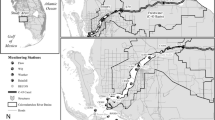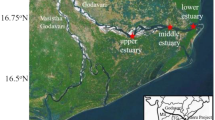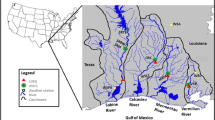Abstract
The excessive input of nitrogen (N) and phosphorus (P) from anthropogenic activities is the main reason behind the cultural eutrophication and algal blooms in freshwater ecosystems. Here, I present a comprehensive budget of N, P for a large reservoir (Lake Diefenbaker) within a highly cultivated watershed. I constructed a 4-year nutrient budget from 2011 to 2014, using grab samples and daily flow data, and a multi-decadal (1978 through 2014) budgeting to examine the effect of inter-annual variability of water residence time on retention of N and P, and if retention of N and P is affected differently. The 4-year budget showed that the reservoir was a net source of total nitrogen (TN) during 2011 and 2014, but a net sink during 2012 and 2013. This resulted in retention coefficients of − 35% and − 4% in 2011 and 2014, respectively. With respect to the total phosphorus (TP) budget, the reservoir acted as a net sink in all 4 years, with a mean retention coefficient of 87%. Consistent with findings of the 4-year budget, the results of the multi-decadal budgeting showed that the reservoir was a net sink for TP during the period of record with a mean retention of 81% (1583 t/year). Regarding TN, the mean retention was lower (49%, 4836 t/year) and more variable relative to TP over the long term. Unlike TP, the results showed that the retention of TN has been decreasing noticeably since 1978. Overall, the retention of TP in this lake is primarily controlled by in-lake sedimentation and most likely does not change substantially in response to inter-annual variation of hydraulic variables such as water residence time. For TN, the role of sedimentation could be minor in retention process in this reservoir (or similar reservoirs elsewhere), but in-lake biological processes could play a more important role. These findings are useful for understanding the role of larger reservoirs with water residence time of 1–3 years in nutrient retention and how changes in flow and water residence time due to climate variability and water management can influence the nutrient retention efficiency.






Similar content being viewed by others
Data availability
The datasets used and/or analyzed during the current study are available from the corresponding author on reasonable request.
Change history
14 February 2023
This article has been retracted. Please see the Retraction Notice for more detail: https://doi.org/10.1007/s11356-023-25918-5
References
Abirhire O, North RL, Hunter K, Vandergucht D, Hudson J (2016) Do human activities affect phytoplankton biomass and composition in embayments on Lake Diefenbaker? J Freshw Ecol 31(4):597–608
Abirhire O, North RL, Hunter K, Vandergucht D, Sereda J, Hudson J (2015) Environmental factors influencing phytoplankton communities in Lake Diefenbaker, Saskatchewan, Canada. J Great Lakes Res 41(2):118–128
Akbarzadeh Z, Maavara T, Slowinski S, Van Cappellen P (2019) Effects of damming on river nitrogen fluxes: a global analysis. Glob Biogeochem Cycles 33:1339–1357
Alexander RB, Elliott AH, Shankar U, Mcbride GB (2002) Estimating the sources and transport of nutrients in the Waikato River Basin, New Zealand. Water Resour Res 38(12):1268
Appling AP, Leon MC, McDowell WH (2015) Reducing bias and quantifying uncertainty in watershed flux estimates: the R package loadflex. Ecosphere 6(12):art269
Bachmann RW, Canfield DE (1996) Use of an alternative method for monitoring total nitrogen concentrations in Florida lakes. Hydrobiologia. 323:1–8
Beusen AH, Bouwman AF, Van Beek LP, Mogollón JM, Middelburg JJ, Beek LP, Van Mogollón JM, Middelburg JJ (2016) Global riverine N and P transport to ocean increased during the 20th century despite increased retention along the aquatic continuum. Biogeosciences 13(8):2441–2451
Billen G (1990) N-budget of the major rivers discharging into the continental coastal zone of the North Sea: the nitrogen paradox, In: Lancelot C. Billen G, Barth H (eds). Eutrophication and algal blooms in North Sea coastal zones, the Baltic and adjacent area: Prediction and assessment of prevention actions. http://publications.europa.eu/en/publication-detail/-/publication/4e6f7808-6bc2-475f-934b-f99f92b7f3aa. Accessed 20 Oct 2019
Billen G, Garnier J, Némery J, Sebilo M, Sferratore A, Barles S, Benoit P, Benoît M (2007) A long-term view of nutrient transfers through the Seine river continuum. Sci Total Environ 375(1–3):80–97
Booth EL, Byrne JM, Johnson DL (2012) Climatic changes in western North America, 1950–2005. Int J Climatol 32(15):2283–2300
Bosch NS, Johengen TH, Allan JD, Kling GW (2009) Nutrient fluxes across reaches and impoundments in two southeastern Michigan watersheds. Lake Reserv Manag 25(4):389–400
Bouwman AF, Bierkens MF, Griffioen J, Hefting MM, Middelburg JJ, Middelkoop H, Slomp CP (2013) Nutrient dynamics, transfer and retention along the aquatic continuum from land to ocean: towards integration of ecological and biogeochemical models. Biogeosciences 10(1):1–22
Brown JB, Sprague LA, Dupree JA (2011) Nutrient sources and transport in the Missouri River Basin, with emphasis on the effects of irrigation and reservoirs. JAWRA J Am Water Resour Assoc 47(5):1034–1060
Burke A (2016) Water quality and nutrient load in the South Saskatchewan River Basin, SK, Canada. Saskatchewan. M.Sc. Dissertation, University of Saskatchewan, Saskatoon, Canada
Canfield DE, Bachmann RW (1981) Prediction of total phosphorus concentrations, chlorophyll a, and Secchi Depths in natural and artificial lakes. Can J Fish Aquat Sci 38(4):414–423
Chambers P, Guy M, Roberts E, Charlton M, Kent R, Gagnon C, Grove G, Foster N (2001) Nutrients and their impact on the Canadian environment. Environment Canada, Ottawa
Chapra SC (1997) Surface water-quality modeling. The McGraw-Hill Companies, Inc., New York
Cohn TA, Caulder DL, Gilroy EJ, Zynjuk LD, Summers RM (1992) The validity of a simple statistical model for estimating fluvial constituent loads: an Empirical study involving nutrient loads entering Chesapeake Bay. Water Resour Res 28(9):2353–2363
Cook PLM, Aldridge KT, Lamontagne S, Brookes JD (2010) Retention of nitrogen, phosphorus and silicon in a large semi-arid riverine lake system. Biogeochemistry. 99(1-3):49–63
Costa D (2011) Eutrophication of Lake Diefenbaker. M.Sc. Dissertation, Imperial College London.
Dillon PJ (1975) The phosphorus budget of Cameron Lake, Ontario: the importance of flushing rate to the degree of eutrophy of lakes. Limnol Oceanogr 20(1):28–39
Ding L, Hannoun IA, List EJ, Tietjen T (2014) Development of a phosphorus budget for Lake Mead. Lake Reserv Manag 30(2):143–156
Dodds WK, Bouska WW, Eitzmann JL, Pilger TJ, Pitts KL, Riley AJ, Schloesser JT, Thornbrugh DJ (2009) Eutrophication of U.S. freshwaters: analysis of potential economic damages. Environ Sci Technol 43(1):12–19
Doig LE, North RL, Hewlett C, Hudson J, Lindenschmidt KE, Liber K (2017) Phosphorus release from sediments in a river-valley reservoir in the northern Great Plains of North America. Hydrobiologia. 787(1):323–339
Donald DB, Parker BR, Davies JM, Leavitt PR (2015) Nutrient sequestration in the Lake Winnipeg watershed. J Great Lakes Res 41(2):630–642
Dorff E, Beaulieu MS (2014) Feeding the soil puts food on your plate. https://www150.statcan.gc.ca/n1/pub/96-325-x/2014001/article/13006-eng.htm (accessed 07.27.19)
Drury CF, Yang JY, De Jong R, Huffman T, Reid K, Yang XM, Bittman S, Desjardins R (2016) Residual Soil Nitrogen. In: Clearwater, R.L., Martin, T. and Hoppe, T. (eds) Environmental sustainability of Canadian agriculture: agri-environmental indicator report series Report #4, Agriculture and Agri-Food Canada. 114–120
Dubourg P, North RL, Hunter K, Vandergucht DM, Abirhire O, Silsbe GM, Guildford SJ, Hudson JJ (2015) Light and nutrient co-limitation of phytoplankton communities in a large reservoir: Lake Diefenbaker, Saskatchewan, Canada. J Great Lakes Res 41(2):129–143
Dumanski S, Pomeroy JW, Westbrook CJ (2015) Hydrological regime changes in a Canadian Prairie basin. Hydrol Process 29(18):3893–3904
Durand P, Breuer L, Johnes PJ (2011) Nitrogen processes in aquatic ecosystems. In: Sutton MA, Howard CM, Erisman JW (eds) The European Nitrogen Assessment. Cambridge University Press
Environment Canada (2015) Phosphorus in aquatic ecosystems: highlights of a national level assessment of nutrients in Canadian watersheds. http://canada.ca/en/environment-climate-change/services/freshwater-quality-monitoring/publications/phosphorus-aquatic-ecosystems.html (accessed 2.26.19)
Finlay JC, Small GE, Sterner RW (2013) Human influences on nitrogen removal in lakes. Science. 342(6155):247–250
Galloway JN, Dentener FJ, Capone DG, Boyer EW, Howarth RW, Seitzinger SP, Asner GP, Cleveland CC, Green PA, Holland EA, Karl DM, Michaels AF, Porter JH, Townsend AR, Vöosmarty CJ (2004) Nitrogen cycles: past, present, and future. Biogeochemistry. 70(2):153–226
Garnier J, Bruno L, Nathalie S, Philippon X (1999) Biogeochemical mass-balances (C, N, P, Si) in three large reservoirs of the Seine basin (France). Biogeochemistry. 47(2):119–146
Gill AC, McHenry JR, Ritchie JC (1976) Efficiency of nitrogen, carbon, and phosphorus retention by small agricultural reservoirs. J Environ Qual 5(3):310–315
Gooding RM, Baulch HM (2017) Small reservoirs as a beneficial management practice for nitrogen removal. J Environ Qual 46:96–104
Grantz EM, Haggard BE, Scott JT (2014) Stoichiometric imbalance in rates of nitrogen and phosphorus retention, storage, and recycling can perpetuate nitrogen deficiency in highly-productive reservoirs. Limnol Oceanogr 59(6):2203–2216
Gray DM, Landine PG (1988) An energy-budget snowmelt model for the Canadian Prairies. Can J Earth Sci 25:1292–1303
Green MB, Finlay JC (2010) Patterns of hydrologic control over stream water total nitrogen to total phosphorus ratios. Biogeochemistry. 99(1-3):15–30
Håkanson L (2005) The importance of lake morphometry and catchment characteristics in limnology–ranking based on statistical analyses. Hydrobiologia. 541(1):117–137
Hall RI, Leavitt PR, Dixit AS, Quinlan R, Smol JP (1999) Limnological succession in reservoirs: a paleolimnological comparison of two methods of reservoir formation. Can J Fish Aquat Sci 56(6):1109–1121
Hamilton HA, Ivanova D, Stadler K, Merciai S, Schmidt J, van Zelm R, Moran D, Wood R (2018) Trade and the role of non-food commodities for global eutrophication. Nat Sustain 1(6):314–321
Harrison JA, Maranger RJ, Alexander RB, Giblin AE, Jacinthe PA, Mayorga E, Seitzinger SP, Sobota DJ, Wollheim WM (2009) The regional and global significance of nitrogen removal in lakes and reservoirs. Biogeochemistry 93(1-2):143–157
Havens K, Fukushima T, Xie P, Iwakuma T, James R, Takamura N, Hanazato T, Yamamoto T (2001) Nutrient dynamics and the eutrophication of shallow lakes Kasumigaura (Japan), Donghu (PR China), and Okeechobee (USA). Environ Pollut 111(2):263–272
Hirsch RM, Moyer DL, Archfield SA (2010) Weighted regressions on time, discharge, and season (WRTDS), with an application to Chesapeake Bay River inputs. J Am Water Resour Assoc 46(5):857–880
Howarth RW, Billen G, Swaney D, Townsend A, Jaworski N, Lajtha K, Downing JA, Elmgren R, Caraco N, Jordan T, Berendse F, Freney J, Kudeyarov V, Murdoch P, Zhao-Liang Z (1996) Regional nitrogen budgets and riverine N & P fluxes for the drainages to the North Atlantic Ocean: natural and human influences. Biogeochemistry 35:75–139
Hudson JJ, Vandergucht DM (2015) Spatial and temporal patterns in physical properties and dissolved oxygen in Lake Diefenbaker, a large reservoir on the Canadian Prairies. J Great Lakes Res 41(2):22–33
James RT, Jones BL, Smith VH (1995) Historical trends in the Lake Okeechobee ecosystem II. Nutrient budgets. Arch Hydrobiol 107:25–47
Janus LL, Soballe DM, Jones BL (1990) Nutrient budget analyses and phosphorus loading goal for Lake Okeechobee, Florida. SIL Proceedings (1922–2010) 24(1):538–546
Jones CA, Welch EB (1990) Internal phosphorus loading related to mixing and dilution in a dendritic, shallow prairie lake. Res J Water Pollut Control Fed 62(7):847–852
Kelly VJ (2001) Influence of reservoirs on solute transport: a regional-scale approach. Hydrol Process 15:1227–1249
Kõiv T, Nõges T, Laas A (2011) Phosphorus retention as a function of external loading, hydraulic turnover time, area and relative depth in 54 lakes and reservoirs. Hydrobiologia 660(1):105–115
Lucas BT, Liber K, Doig LE (2015) Reconstructing diatom and chironomid assemblages to infer environmental spatiotemporal trends within Lake Diefenbaker, a narrow river-valley reservoir on the Canadian Prairies. J Great Lakes Res 41(2):45–55
Maavara T, Parsons CT, Ridenour C, Stojanovic S, Dürr HH (2015) Global phosphorus retention by river damming. Proc Natl Acad Sci 112(51):15603–15,608
Marsh N, Waters D (2009) Comparison of load estimation methods and their associated error. In: Anderssen RS, Braddock RD, Newham LT (eds). The 18th World IMACS Congress and MODSIM09 International Congress on Modelling and Simulation, Cairns. 3322–3328
Morales-Marín L, Wheater H, Lindenschmidt KE (2017) Assessment of nutrient loadings of a large multipurpose prairie reservoir. J Hydrol 550:166–185
Nixon SW, Granger SL, Nowicki BL (1996) An assessment of the annual mass balance of carbon, nitrogen, and phosphorus in Narragansett Bay. Biogeochemistry 31(1):15–61
North RL, Johansson J, Vandergucht DM, Doig LE, Liber K, Lindenschmidt K, Baulch H, Hudson JJ (2015) Evidence for internal phosphorus loading in a large prairie reservoir (Lake Diefenbaker, Saskatchewan). J Great Lakes 41(2):91–99
Nürnberg GK, Tarvainen M, Ventela AM, Sarvala J (2012) Internal phosphorus load estimation during biomanipulation in a large polymictic and mesotrophic lake. Inl Waters 2(3):147–162. https://doi.org/10.5268/IW-2.3.469
Nürnberg GK (1984) The prediction of internal phosphorus load in lakes with anoxic hypolimnia. Limnol Oceanogr 29(1):111–124
O’Brien KR, Weber TR, Leigh C, Burford MA (2016) Sediment and nutrient budgets are inherently dynamic: evidence from a long-term study of two subtropical reservoirs. Hydrol Earth Syst Sci 20(12):4881–4894
Orihel DM, Baulch HM, Casson NJ, North RL, Parsons CT, Seckar DC, Venkiteswaran JJ (2017) Internal phosphorus loading in Canadian fresh waters: a critical review and data analysis. Can J Fish Aquat Sci 74(12):2005–2029
Patoine A, Graham MD, Leavitt PR (2006) Spatial variation of nitrogen fixation in lakes of the northern Great Plains. Limnol Oceanogr 51(4):1665–1677
Parsons TR, Maita Y, Lalli CM (1984) A manual of chemical and biological methods for seawater analysis. Pergamon Press, Oxford
Pomeroy JW, Shook KR (2012) Review of Lake Diefenbaker Operations, 2010–2011. Centre for Hydrology, University of Saskatchewan, Saskatoon. Final report to the Saskatchewan Watershed Authority
Powers SM, Bruulsema TW, Burt TP, Chan NI, Elser JJ, Haygarth PM, Howden NJ, Jarvie HP, Lyu Y, Peterson HM, Sharpley AN, Worrall FN, Zhang F, Shen J, Worrall FN, Zhang F (2016) Long-term accumulation and transport of anthropogenic phosphorus in three river basins. Nat Geosci 9:353–356
Powers SM, Tank JL, Robertson DM (2015) Control of nitrogen and phosphorus transport by reservoirs in agricultural landscapes. Biogeochemistry 124(1–3):417–439
Prairie YT, de Montigny C, Del Giorgio PA (2001) Anaerobic phosphorus release from sediments: a paradigm revisited. Verh Int Ver Theor Angew Limnol 27(7):4013–4020
Reid K, Schneider K, Joosse P (2019) Addressing imbalances in phosphorus accumulation in Canadian agricultural soils. J Environ Qual 48:1156–1166
Runkel RL, Crawford CG, Cohn T (2004) Load Estimator (LOADEST): a FORTRAN program for estimating constituent loads in streams and rivers. Techniques and Methods Book 4, Chapter A5. U.S. Geological Survey. World 69
Sadeghian A (2017) Water quality modeling of Lake Diefenbaker. Ph.D. Dissertation, University of Saskatchewan. Saskatoon, Saskatchewan
Schindler DW (2012) The dilemma of controlling cultural eutrophication of lakes. Proc R Soc Lond B Biol Sci 279(1746):4322–4333
Schindler DW, Hecky R, McCullough G (2012) The rapid eutrophication of Lake Winnipeg: greening under global change. J Great Lakes Res 38(3):6–13
Schindler DW, Hecky RE, Findlay DL, Stainton MP, Parker BR, Paterson MJ, Beaty KG, Lyng M, Kasian SE (2008) Eutrophication of lakes cannot be controlled by reducing nitrogen input: results of a 37-year whole-ecosystem experiment. Proc Natl Acad Sci 105(32):11254–11258
Seitzinger SP, Styles RV, Boyer EW, Alexander RB, Billen G, Howarth RW, Mayer B, Breemen N (2002) Nitrogen retention in rivers: model development and application to watersheds in the northeastern US. Biogeochemistry 57(1):199–237
[SEPS and EC]Saskatchewan Environment and Public Safety, Water Quality Branch and Environment Canada, Inland Waters Directorate, Water Quality Branch (1988) Lake Diefenbaker and Upper South Saskatchewan River: Water Quality Study 1984–85. Saskatchewan Environment and Public Safety, Regina, SK.
Shafiei F, McLoughlin PD (2017) Change in nutrient loading pattern due to coupled effect of change in concentration and hydroclimatic forces. J Freshw Ecol 32(1):773–792
Shook K, Pomeroy J (2012) Changes in the hydrological character of rainfall on the Canadian Prairies. Hydrol Process 26(12):1752–1766
Shook K, Pomeroy J (2015) The effects of the management of Lake Diefenbaker on downstream flooding. Can Water Resour J 41(1–2):261–272
Smith RA, Schwarz GE, Alexander RB (1997) Regional interpretation of water-quality monitoring data. Water Resour Res 33(12):2781–2798
Smith VH (2003) Eutrophication of freshwater and coastal marine ecosystems: a global problem. Environ Sci and Pollut R 10(2):126–139
Soballe DM (2007) FLUX32, Windows-based interactive software for examinations and evaluations of data and flow relations and calculation of material fluxes (loads) in streams. https://www.pca.state.mn.us/wplmn/flux32. (accessed 9.21.19)
Vanni MJ, Renwick WH, Bowling AM, Horgan MJ, Christian AD (2011) Nutrient stoichiometry of linked catchment-lake systems along a gradient of land use. Freshw Biol 56:791–811
Wheater H, Gober P (2013) Water security in the Canadian Prairies: science and management challenges. Philos Trans R Soc A Math Phys Eng Sci 371(2002):1–21
Winder M (2012) Limnology: lake warming mimics fertilization. Nat Clim Chang 2:771–772
Windolf J, Jeppesen E, Jensen J, Kristensen P (1996) Modelling of seasonal variation in nitrogen retention and in-lake concentration: a four-year mass balance study in 16 shallow Danish lakes. Biogeochemistry. 33(1):25–44
Acknowledgments
I greatly appreciate the critical and constructive comments from the reviewers. I thank the Saskatchewan Water Security Agency for providing access to the long-term data.
Funding
The water quality data of the 4-year study were collected during my PhD, funded by grants awarded to Dr. Jeff Hudson through the Global Institute for Water Security, the Saskatchewan Water Security Agency (WSA-2014A-0001) and NSERC (RGPIN-250060-20).
Author information
Authors and Affiliations
Contributions
This manuscript is from a data chapter of my defended/passed PhD dissertation. I am the only contributor of this manuscript including the analyses and the writing.
Corresponding author
Ethics declarations
Consent for publication
I hereby give my consent for this manuscript and the supporting documents to be published by the journal of Environmental Science and Pollution Research.
Competing interests
The author declares that he has no competing interests.
Additional information
Responsible editor: Thomas Hein
Publisher’s Note
Springer Nature remains neutral with regard to jurisdictional claims in published maps and institutional affiliations.
This article has been retracted. Please see the retraction notice for more detail: https://doi.org/10.1007/s11356-023-25918-5
Supplementary Information:
ESM 1
(DOCX 5.36 mb)
Rights and permissions
Springer Nature or its licensor (e.g. a society or other partner) holds exclusive rights to this article under a publishing agreement with the author(s) or other rightsholder(s); author self-archiving of the accepted manuscript version of this article is solely governed by the terms of such publishing agreement and applicable law.
About this article
Cite this article
Shafiei, F. RETRACTED ARTICLE: Nutrient mass balance of a large riverine reservoir in the context of water residence time variability. Environ Sci Pollut Res 28, 39082–39100 (2021). https://doi.org/10.1007/s11356-021-13297-8
Received:
Accepted:
Published:
Issue Date:
DOI: https://doi.org/10.1007/s11356-021-13297-8




